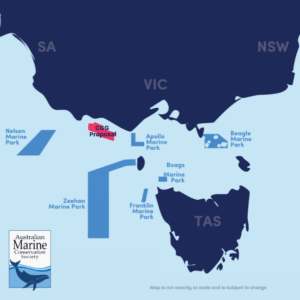Seismic testing is the first step in oil and gas exploration in our oceans.
Seismic vessels tow an array of airguns and audio receivers (hydrophones) behind them. These powerful airguns fire loud blasts of compressed air every 10 to 15 seconds. The sound waves produced penetrate deep into the seabed, and those that bounce back to the sea surface are detected by the audio receivers. From the sound patterns detected, geologists can work out the most likely place to find oil and gas reserves trapped in the ocean bedrock. The next step is exploratory drilling.
View this post on Instagram
How does seismic blasting affect marine life?
Seismic blasting involves multiple air guns firing every 10 to 15 seconds, all day, every day, for weeks to months on end. The noise generated by seismic airguns under water reaches a massive 250 decibels – it needs to penetrate through rock!
How loud is seismic blasting? It’s hard to make a meaningful comparison with loud noises above and below water. For a start, decibels are measured differently in air than in water – 100 decibels in the air is not the same as 100 decibels underwater. To add complexity, the scale used to measure decibels is not linear, it’s logarithmic. This means that 20 decibels is 10 times the intensity of 10 decibels. 30 decibels is 100 times more intense than 10 decibels. The loudest underwater sounds made by whales measure in the range of 140–190 decibels¹. A 250 decibel seismic blast is 1,000,000 times more intense than the loudest whale sounds!
Evidence that seismic blasting harms marine life is growing. The sound travels under water faster than it does through air, and can travel for hundreds to thousands of kilometres. It can kill or injure marine animals close by – even tiny zooplankton more than a kilometre away.
Seismic blasts can damage the hearing of whales and keep them away from key feeding and breeding grounds.² Other large animals like dolphins, sea turtles, and sea lions could suffer similar effects. We can only imagine how distressing seismic blasts must be for marine animals, like whales and dolphins, that rely on sound to navigate and for communicating over vast distances.
Seismic blasting probably has the greatest impacts on those species that can’t escape the blast area quickly, like zooplankton and shellfish.
Zooplankton, the very basis of ocean food chains, is at risk³. These tiny floating or weakly swimming animals rely on water currents to move large distances. Zooplankton includes a range of tiny crustaceans, like krill and copepods, as well the larvae of many larger animals like crabs, lobsters, octopuses and fishes. After seismic blasts, many zooplankton are found dead⁴, even as far away as 1.2 kilometres from the blast site.
The behaviour of scallops changes during and after exposure to blasts.⁵ It damages their hemolymph (the scallop’s equivalent of blood), and their immune systems, and ultimately weakens them so they’re more likely to die early. Similar impacts have been shown in spiny lobsters.⁶
Scallops and lobsters are both important seafood species, so seismic blasting also impacts current and future catch rates for our commercial fisheries. In 2020, fishers reported a massive decline in catches after two seismic vessels started seismic testing for oil and gas in the waters east of Victoria.
Listen to explainer on Seismic Blasting from Dr Cat Dorey, AMCS Campaigner (starts at 2.10 min)
Does seismic blasting happen in Australia?
Yes, and it is increasing with plans to expand offshore oil and gas projects. Seismic blasting and oil and gas exploration is going on in our waters, including in our marine parks and close to our iconic coastlines. And there could be more coming.
Over 2021 and 2022, the Federal government allocated 31 new areas for offshore oil and gas exploration.⁷ One area known as the Otway Basin is just south-east of Port Campbell in Victoria, and 5 kms from the beautiful Twelve Apostles. You can see this area from the Great Ocean Road. While another recent release is off the coast of Gippsland in Victoria. Four of the release areas are within the Zeehan Marine Park, west of King Island, Tasmania. ConocoPhillips, a US oil and gas company, has already begun seismic testing there.⁸
Over in Western Australia, there are new potential oil and gas exploration areas within the Kimberley and Montebello Marine Parks.

CGG’s seismic blasting project proposed in south-east Australia’s oceans. Map is not to exact scale and is subject to change.
Download our Protecting Australia’s marine life from seismic blasting (2024) flyer.
What can you do to help?
After overwhelming public outrage and the damage done to our marine life by seismic blasting, the Senate held an Inquiry in 2020 into the impact of seismic testing on fisheries and the marine environment.
One clear recommendation from the Senate Inquiry⁹ is that seismic blasting must be banned from marine parks, and it doesn’t belong in critical marine habitats.
Despite this – and the dire warnings about burning any more fossil fuels in the face of climate change¹⁰ – the Australian government continues to open up new areas for oil and gas exploration in our oceans. October of every year the federal government opens bidding to oil and gas companies to make bids for more projects, which leads to more exploration with seismic blasting.
You’ve seen that when we work together to protect our oceans we can influence decision makers. Help us turn up the volume against seismic blasting and the expansion of oil and gas, and protect our marine parks and the vulnerable wildlife that call the ocean home.
References
¹ https://dosits.org/science/sounds-in-the-sea/what-are-common-underwater-sounds/
² http://www.pelagosinstitute.gr/gr/pelagos/pdfs/Gordon%20et%20al.%202004,%20Review%20of%20Seismic%20Surveys%20Effects.pdf
³ https://australian.museum/learn/animals/plankton/zooplankton/
⁴ https://www.nature.com/articles/s41559-017-0195
⁵ https://www.pnas.org/content/pnas/114/40/E8537.full.pdf
⁶ https://www.sciencedirect.com/science/article/abs/pii/S0025326X17306744?via%3Dihub
⁷ https://www.ga.gov.au/scientific-topics/energy/province-sedimentary-basin-geology/petroleum/acreagerelease/subbasins
⁸ https://www.theguardian.com/australia-news/2021/aug/28/frustration-and-angst-king-island-residents-protest-as-us-energy-giant-starts-seismic-testing
⁹ https://www.aph.gov.au/Parliamentary_Business/Committees/Senate/Environment_and_Communications/SeismicTesting/Report
¹⁰ https://www.ipcc.ch/report/ar6/wg1